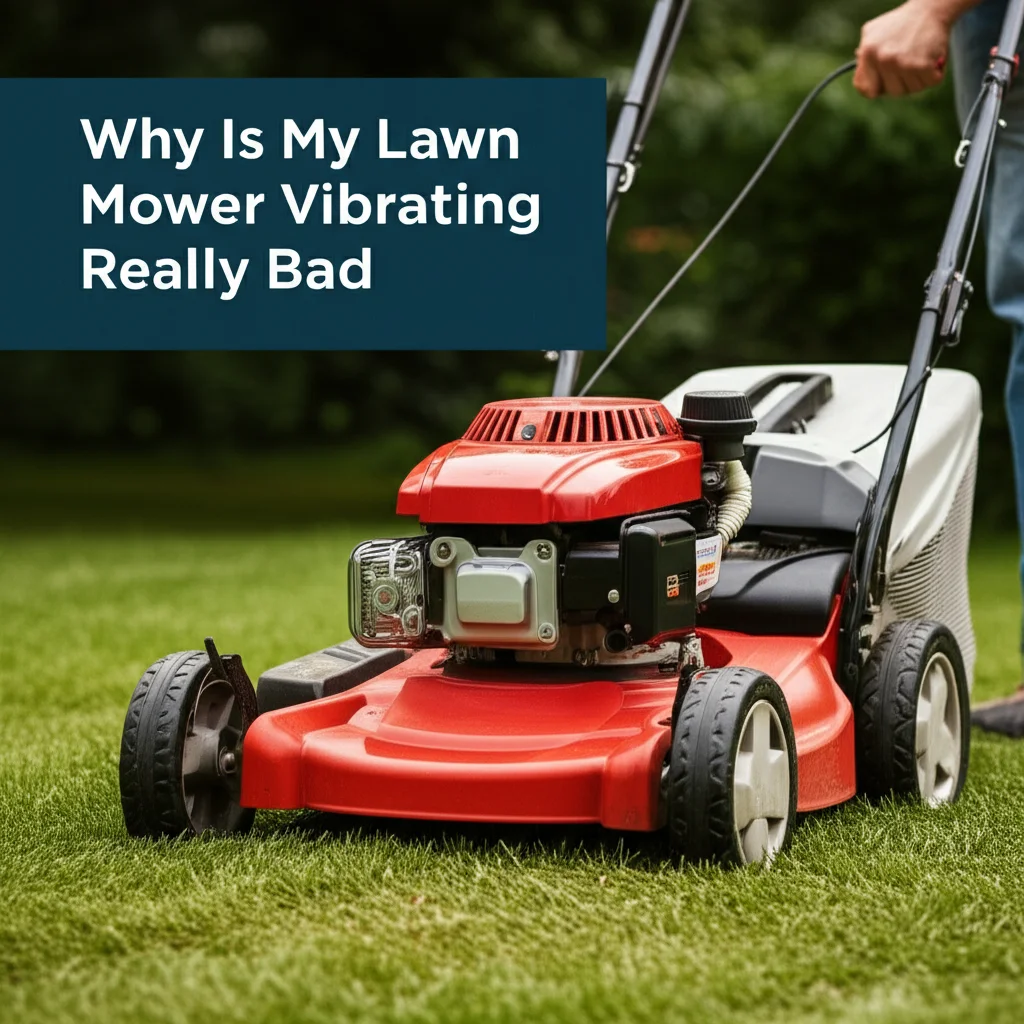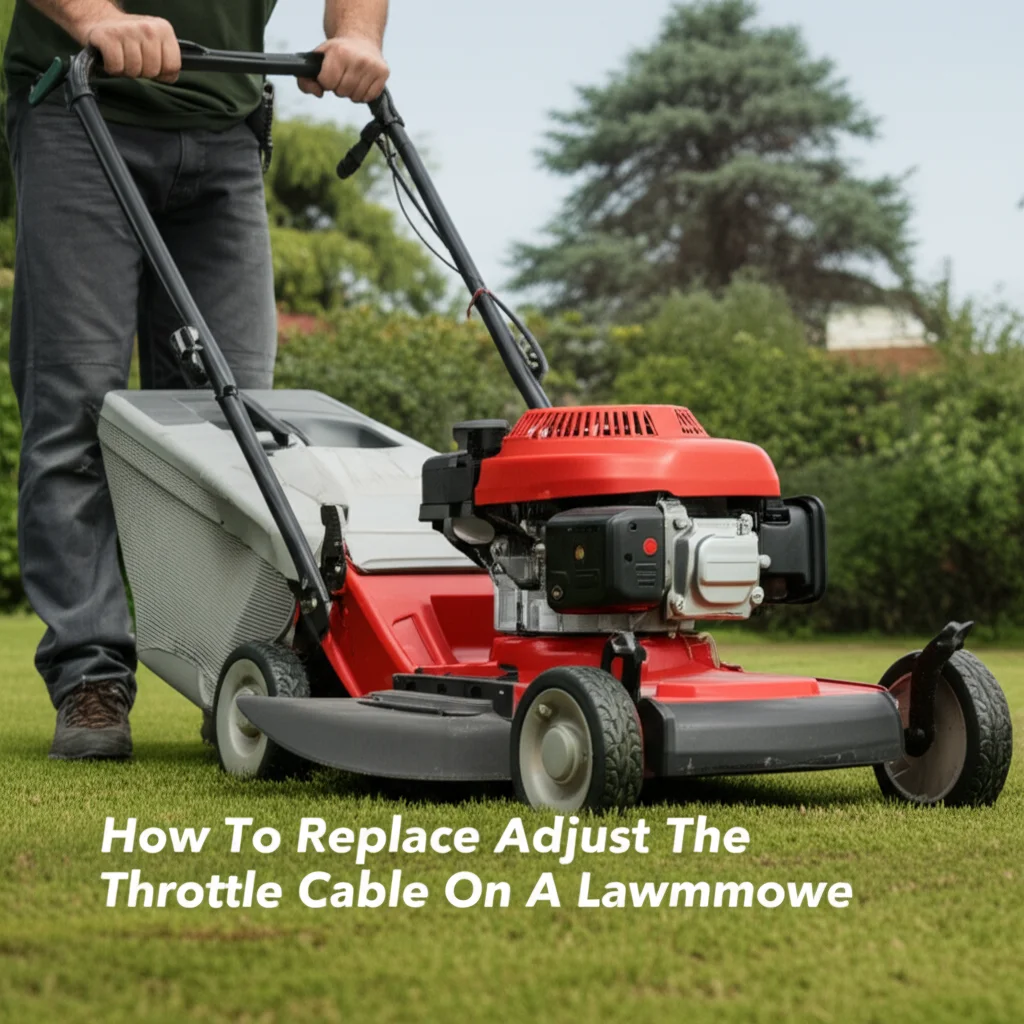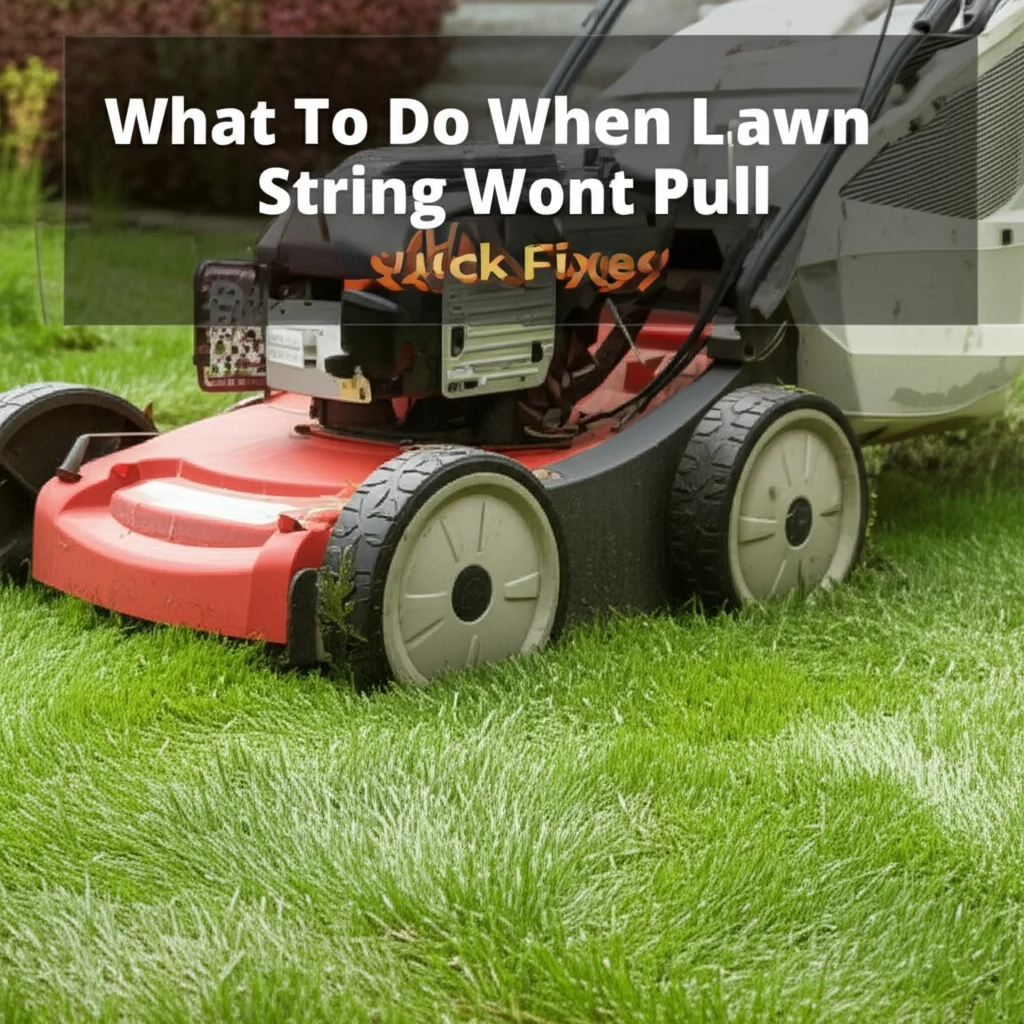· Lawn Mower Maintenance · 12 min read
Why Is My Lawn Mower Vibrating Really Bad

Why Is My Lawn Mower Vibrating Really Bad? 8 Common Causes & Solutions
Have you noticed your lawn mower vibrating really bad during your last few mowing sessions? Excessive vibration isn’t just annoying—it’s often a warning sign that something needs immediate attention.
Whether you’re dealing with a riding mower or push mower, unusual vibrations can indicate serious mechanical issues that, if left unchecked, could lead to costly repairs or even safety hazards.
Key Takeaways
• Damaged or unbalanced blades are the most common cause of severe lawn mower vibration
• Bent crankshaft from hitting rocks or debris creates persistent shaking that worsens over time
• Loose bolts and connections throughout the mower can amplify vibration issues
• Engine problems including worn mounts and internal damage contribute to excessive shaking
• Regular maintenance and immediate attention to new vibrations prevent costly repairs
Quick Answer: A badly vibrating lawn mower usually indicates damaged or unbalanced blades, a bent crankshaft from impact damage, loose mounting bolts, or worn engine components that need immediate inspection and repair.
Understanding Normal vs. Excessive Lawn Mower Vibration
Every lawn mower produces some level of vibration during operation—this is completely normal. The engine’s combustion process, rotating blades, and mechanical components naturally create minor vibrations. However, when your lawn mower starts vibrating really bad, you’ll notice the difference immediately.
Normal vibration feels steady and consistent, barely noticeable through the handles or seat. Excessive vibration, on the other hand, creates noticeable shaking that makes the mower difficult to control, causes your hands to tingle, or makes the entire machine feel unstable.
The key is recognizing when vibration crosses from normal operation into problematic territory. If you find yourself having to grip the handles tighter or if the vibration has noticeably increased compared to previous mowing sessions, it’s time to investigate the cause.
Damaged or Unbalanced Lawn Mower Blades
The most frequent culprit behind severe mower vibration is blade-related issues. Your mower blades need to be perfectly balanced and in good condition to operate smoothly. When blades become damaged, bent, or unbalanced, they create significant vibration that affects the entire machine.
Signs of Blade Problems
Damaged blades often result from striking rocks, tree roots, or other hard objects while mowing. Even minor nicks or chips can throw off the blade’s balance, while more severe damage can cause dangerous wobbling. You might also notice:
- Uneven cutting patterns in your grass
- Increased noise levels during operation
- Visible chips, cracks, or bent sections on the blade
- Grass clippings scattered unevenly
How to Check and Fix Blade Issues
To inspect your blades, first ensure the mower is completely off and spark plug disconnected for safety. Tilt the mower (air filter side up) or remove the blade for closer examination. Look for any visible damage, wear patterns, or accumulation of grass and debris.
If you discover damage, you’ll need to either sharpen and balance the blade or replace it entirely. For balance testing, hang the blade on a nail through its center hole—a balanced blade will hang level, while an unbalanced one will tilt toward the heavier side.
Professional blade sharpening services can restore balance and cutting effectiveness, but severely damaged blades should be replaced. Learning how to properly maintain your lawn mower blades is essential for preventing future vibration issues.
Bent Crankshaft: A Serious Mechanical Issue
A bent crankshaft represents one of the most serious causes of lawn mower vibration. This critical engine component connects the piston to the blade assembly, and when bent, it creates severe wobbling that gets progressively worse over time.
How Crankshafts Get Damaged
Crankshaft damage typically occurs when the mower blade strikes an immovable object while running at full speed. The sudden stop forces tremendous stress on the crankshaft, potentially bending it even if the damage isn’t immediately visible. Common scenarios include:
- Hitting large rocks or concrete edging
- Running over tree stumps or thick roots
- Striking metal objects like sprinkler heads
- Attempting to cut through overly thick vegetation
Identifying Crankshaft Problems
A bent crankshaft creates distinctive symptoms that worsen over time. The mower will vibrate severely, especially at higher RPMs, and you may notice the blade spinning unevenly when viewed from the side. The vibration often feels different from blade-related issues—more violent and throughout the entire machine.
Professional diagnosis is usually required to confirm crankshaft damage, as the bend might be minimal but still cause significant problems. If you suspect crankshaft damage, stop using the mower immediately, as continued operation can cause additional engine damage.
Loose Bolts and Hardware Throughout the Mower
Sometimes the simplest explanation is the correct one. Loose bolts and hardware throughout your mower can create or amplify vibration problems. Regular use naturally loosens various connections, and what starts as minor rattling can develop into severe shaking.
Critical Areas to Check
Focus your inspection on these key areas where loose hardware commonly causes vibration:
The blade mounting bolt is perhaps the most critical—if this becomes loose, it creates dangerous blade wobble and severe vibration. Engine mounting bolts secure the powerplant to the deck, and when loose, they allow the engine to move excessively during operation.
Handle assembly bolts, deck mounting hardware, and wheel attachments should all be checked regularly. Even seemingly minor components like heat shields, guards, and covers can contribute to overall vibration when loose.
Proper Tightening Procedures
When tightening bolts, follow manufacturer specifications for torque values, especially for critical components like blade and engine mounts. Use appropriate tools and avoid over-tightening, which can strip threads or damage components.
Check hardware before each mowing session as part of your routine maintenance. A few minutes of inspection can prevent hours of troubleshooting and potentially dangerous operating conditions.
Engine-Related Vibration Problems
Engine issues can manifest as excessive vibration, particularly when internal components wear out or become damaged. These problems often develop gradually, making them harder to notice until they become severe.
Worn Engine Mounts
Engine mounts absorb vibration and secure the powerplant to the mower deck. Over time, these rubber and metal assemblies deteriorate, allowing increased engine movement that translates to excessive vibration throughout the machine.
Signs of worn engine mounts include visible cracking or separation of rubber components, metal-to-metal contact where rubber should provide cushioning, and excessive engine movement when the throttle is blipped.
Internal Engine Problems
More serious internal engine issues can also cause vibration. Worn piston rings, damaged connecting rods, or crankshaft bearing problems create irregular engine operation that results in shaking and rough running.
These problems often accompany other symptoms like difficulty starting, reduced power, unusual exhaust smoke, or irregular engine sounds. If you suspect internal engine damage, professional diagnosis is recommended to avoid costly mistakes.
For engines that won’t start after winter storage or show other performance issues, understanding common starting problems can help identify whether vibration is part of a larger issue pattern.
Deck and Housing Issues
The mower deck itself can contribute to vibration problems when damaged or improperly maintained. Cracks in the deck structure, damaged mounting points, or accumulated debris can all create or amplify existing vibration issues.
Structural Damage
Impact damage that bends or cracks the mower deck affects the entire machine’s stability. Even minor damage can create stress points that develop into larger problems over time. Inspect the deck regularly for cracks, especially around mounting points and high-stress areas.
Rust and corrosion can also weaken deck structure, particularly in areas where moisture accumulates. What starts as surface rust can progress to structural weakness that allows excessive flex during operation.
Debris Accumulation
Grass clippings, leaves, and other debris that accumulate under the deck can create balance issues and restrict airflow. This buildup not only affects cutting performance but can also contribute to vibration as the engine works harder to maintain blade speed.
Regular cleaning prevents debris-related problems and allows you to spot potential issues before they become serious. A clean deck also operates more efficiently and produces better cutting results.
Impact Damage: When Your Mower Hits Obstacles
Understanding what happens when your lawn mower strikes solid objects helps explain many vibration problems. The forces involved in these impacts can cause immediate damage or create weaknesses that develop into problems over time.
Immediate vs. Delayed Effects
Some impact damage creates immediate vibration that’s impossible to ignore. Severely bent blades or obvious crankshaft damage falls into this category. However, many impacts cause subtle damage that develops into noticeable problems after hours of operation.
Hairline cracks in blades, slight crankshaft bends, or loosened hardware might not create immediate symptoms but will worsen over time. This is why it’s important to inspect your mower after any significant impact, even if it seems to run normally afterward.
Prevention Strategies
The best approach to impact damage is prevention. Walk your mowing area before starting to identify potential hazards like rocks, toys, or debris. Mark permanent obstacles like sprinkler heads or decorative elements so you can avoid them consistently.
Maintain appropriate mowing height to avoid scalping that brings blades into contact with ground-level obstacles. If you do strike something while mowing, stop immediately and inspect for damage before continuing.
When your mower experiences problems after striking obstacles, understanding what happens when lawn mowers hit rocks can guide your troubleshooting approach.
Maintenance and Prevention Tips
Regular maintenance is your best defense against vibration problems. Most vibration issues develop gradually and can be prevented with proper care and attention to early warning signs.
Regular Inspection Schedule
Develop a routine inspection schedule that includes checking blade condition, hardware tightness, and overall machine condition. Before each use, do a quick visual inspection for obvious problems. Monthly or seasonal inspections should be more thorough, including blade removal and detailed examination.
Keep records of maintenance performed and problems encountered. This documentation helps identify patterns and ensures important maintenance isn’t overlooked.
Proper Storage and Care
Proper storage protects your mower from environmental damage that can contribute to vibration problems. Clean the machine thoroughly before storage, removing all grass clippings and debris that could cause corrosion.
Store in a dry location when possible, and consider using a cover to protect against moisture and dust. Proper storage practices extend mower life and reduce the likelihood of developing vibration issues during storage periods.
For those storing mowers in basements or other indoor locations, understanding safe storage practices ensures both equipment protection and safety.
When to Seek Professional Help
While many vibration issues can be diagnosed and fixed by homeowners, some problems require professional expertise. Knowing when to seek help can save time, money, and prevent safety hazards.
Safety Considerations
Never continue operating a mower with severe vibration, as this can lead to component failure and potential injury. If vibration is accompanied by unusual noises, smoke, or loss of control, stop immediately and seek professional diagnosis.
Crankshaft problems, internal engine damage, and complex electrical issues typically require professional repair. Attempting DIY repairs on these systems without proper knowledge and tools can be dangerous and expensive.
Cost vs. Repair Decisions
Sometimes repair costs exceed the mower’s value, making replacement more economical. Professional technicians can provide honest assessments of repair costs versus replacement value, helping you make informed decisions about your equipment.
Consider the mower’s age, overall condition, and your long-term needs when evaluating repair versus replacement options. A professional evaluation provides the information needed to make the best choice for your situation.
Frequently Asked Questions
What does a badly vibrating mower usually indicate? A badly vibrating mower typically indicates damaged or unbalanced blades, a bent crankshaft from impact damage, loose mounting hardware, or worn engine components. The severity and pattern of vibration can help identify the specific cause, but professional diagnosis may be needed for complex issues.
How to fix lawn mower vibration? Start by checking and balancing or replacing damaged blades, then inspect and tighten all hardware connections. Clean debris from the deck and examine the crankshaft for damage. If these steps don’t resolve the issue, engine mount replacement or professional diagnosis may be necessary.
How do I know if my lawn mower shaft is bent? Signs of a bent crankshaft include severe vibration that worsens at higher RPMs, visible blade wobble when viewed from the side, difficulty starting, and progressive worsening of symptoms. Professional measurement is often required to confirm crankshaft damage accurately.
Why does my lawn mower feel weak? A weak-feeling mower with vibration issues may have engine problems, clogged air filters, dull blades requiring more power to cut, or fuel delivery issues. The combination of weakness and vibration often indicates multiple problems that need systematic diagnosis and repair.
Can I continue mowing with a vibrating lawn mower? You should stop using a severely vibrating mower immediately, as continued operation can cause additional damage and create safety hazards. Minor vibration might be acceptable temporarily, but any significant increase in vibration requires investigation before further use.
How often should I check my lawn mower for vibration issues? Perform basic vibration checks before each use as part of your pre-operation inspection. More thorough examinations should occur monthly during mowing season and before seasonal storage. Address any changes in vibration patterns immediately to prevent progressive damage.
What tools do I need to fix lawn mower vibration? Basic tools include wrenches for hardware inspection, a blade balancing fixture or nail for balance testing, and cleaning supplies for deck maintenance. More complex repairs may require torque wrenches, pullers, and specialized measuring tools best handled by professionals.
Final Words
Addressing lawn mower vibration problems promptly protects your investment and ensures safe operation. Most vibration issues stem from preventable causes like damaged blades, loose hardware, or lack of regular maintenance.
By understanding the common causes and implementing regular inspection routines, you can keep your mower running smoothly for years to come.
Remember that severe vibration is never normal and should never be ignored. When your lawn mower is vibrating really bad, systematic diagnosis starting with the most common causes usually identifies the problem quickly.
Don’t hesitate to seek professional help for complex issues or when safety is a concern—proper repairs ensure reliable operation and prevent costly damage from progressive wear.
Take action today by inspecting your mower for the issues discussed in this guide, and establish a maintenance routine that will prevent most vibration problems before they start.



